It appears some of you missed Cameron’s post.
I can’t remember when I post got so many comments is such a short time!
“Dear Alastair
For some time I have read your letters with interest and much pleasure. Thank you.
I decided that it was time that I made a contribution and you may wish to share the following with readers:
For some time I have struugled with track cleaning (as have many others!) as my layout has a fair amount of hidden track.
I have examined and tried various commercial cleaners but none has worked.
My conclusion was that the only way to clean track is to scrub it in some way – the Dapol track cleaner with its revolving brush was the only one that made sense to me but the cost is more than I could justify spending.
I have always had the attitude that if a manufacturer can make something then so can I – even if it’s not quite as neat and sophistcated.
Kim’s track cleaner gave me the boot up the rear end that I needed to get started on another one of my own.
I raided my boxes of odds and ends and put them all together to produce something that cost me the price of a battery and a kitchen cleaning pad but nothing else.
I started with a chasis from an old wagon, found a motor from a discarded loco, a gearbox from an electric toothbrush, some bits of scrap metal and plasticard, a metal washer from my washer tin, a pop rivet, nuts, bolts and screws and finally plasticard to build the outer box car casing.
A small piece of wire from a paper clip made a convenient switch on the side.
After some adjustment to the height of the brush. it works a dream and leaves gleaming track, The result can be seen in the photos.
Regards
John”
“Al,
There seems to be questions about how much slope to allow on our layouts so I thought I’d share my solution.
What I did before settling was to do my own testing. I laid out an oval of track on a piece of plywood about two feet by four feet, for n scale this was plenty big enough.
I set it on a table and put together a train as long as I expected to run on my final layout. (I used eight cars). I pick my favorite locomotive and started it around. Then I started lifting the end of my board in small steps looking for the maximum slope my train could go up at slow speed.
Once I had that I tested my other engines and adjusted the slope until it seemed everything worked well.
The final slope was then measured along the track using a level and ruler. That became the maximum slope for my railroad. It turned out to be three percent but I ended up not needing more then two and a half percent. (That’s is two and a half inches rise in one hundred inches of track.
Keep modeling,
Jim”
“Hi Al,
Most of Shell Hill is done, but there is a considerable amount of tune up and landscaping left to do.
Most of my running videos in the past were filmed in one location on my layout. I decided to show a tour around it and while I was filming, I began to make up a story.
The story is about a Mrs. McCrain who is on her way to meet her niece in Kent and she must make a change of train in Shell Hill. I had a lot of fun with it, I hope you and your readers can enjoy my silly fun too. It is quite different than anything else I have done.
At the end, I did a little shunting exercise to demonstrate the shunting capabilities of the new Shell Hill goods facility. It is my first attempt at shunting so it is a little jerky, but it gave me a chance to do a few close ups around Shell Hill.
I really enjoy seeing what others are doing with their railways and the tips and pointers have been very useful. Keep up the great work.
Rob
Latest ebay cheat sheet? It’s here!
A wonderful collection this time. Thanks to everyone. Please do keep ’em coming.
And if today is the day you get bored of sitting on the side lines, the Beginner’s Guide is here.
Best
Al
PS Latest ebay cheat sheet is here.

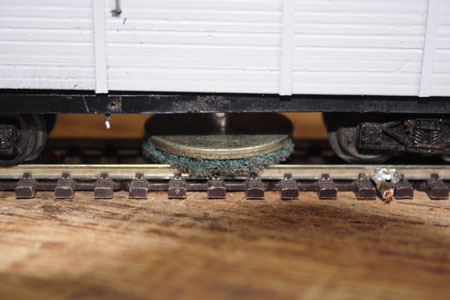
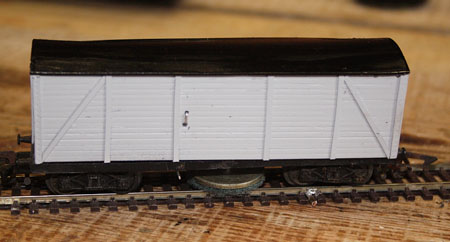
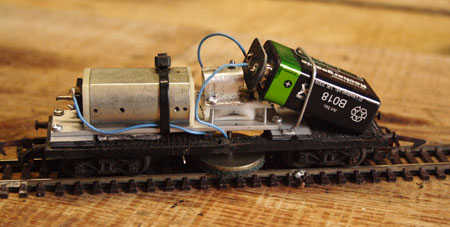

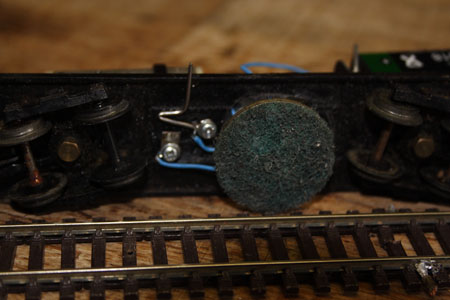
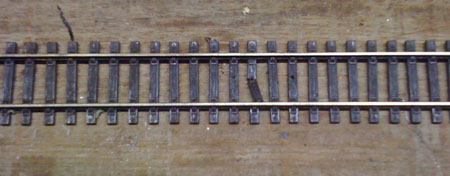

nice if he showed how to assemble
Another way to “cheat” on maximum slope is to put adjustable “feet” on the legs of your table (or shims work as well). If you raise one end of the table an inch or 2 this changes the effective slope and you can get away with steeper slopes. This only works if your trains run in only one direction.
This is neat, but you must watch using rough cleaning items that scratch the top of the rail as later this makes for places that oxidation can occur.
Hi i brought the dapol track cleaner saved up for it and all the exstra bits i have to say was very disappointing
i love the idear of the kitchen scourer i think im going to canabolise my dapol to take that scourer as i have a ton of track all hidden and i hope one day to show you all my layout
thanks for shareing
paul
Quite brilliant Rob, loved the tale of Mrs McCrain. Great showing of the layout which is fantastic. Very impressed with the shunting. Peter
I love the idea of the track cleaner great job !!!!!!!
nice work track cleaning … something we all need to do.
likened the video
best regards
liked the story about Mrs McCrain just one problem though in England her train would have pulled into platform 1 and her connection would have pulled into platform 2 other wise nice one
Good idea for the track cleaner-a step by step video would be a great help for all of us!!
As Ohio Navigation says, those little scratches make places for oxidation to begin. It also makes for hiding places for dirt. I have read that an excellent cleaner is automotive automatic transmission fluid. It is an excellent solvent, and coats the rail to prevent oxidation. It also gets on wheels which follow it and clean and coat them as well. Has anybody tried it? If so, I would like to hear about your experience.
Using a dampened soft cotton pad in place of the scrubbie and having it rotate would make good use of more of the surface of the pad.
Very good track cleaning idea.
Mrs McCrain trip was fun.
Seems to me John’s point is: “Try making your own. You could hit on the best idea yet”.
A good track cleaner is the Holy Grail of model railroading. That one looks pretty convincing to me.
Love the new video Rob, especially the shunting. I think these videos are a way to attract younger people to our great hobby. Thanks for posting.
Cheers
Cameron
awesome need details how to build gearing for ho car also
a suggestion use a spring loaded bright boy track eraser cut to spin as your
track abrasive thankz
blkwingz aka steve
Re gradients, remember that it’s not just the steepness, the drag of the flanges on sharp curves will increase the load on the engine. Don’t just test with a straight length if your layout requires a curve on the bank. The layout I built for my son many years ago had a 1 in 30 grade with curves and this was fine for most realistic trains.
Re track cleaning, would transmission fluid not eat the plastic sleepers? The material recommended to me by a very experienced exhibitor was Wahl hair clipper oil, which does the same job but is not aggressive, try asking your barber.
Re Farland Howe, Rob, those 50s weren’t introduced until 1967 and the large-logo livery was eighties I think, whereas the “blood and custard” coach livery was a 1950s thing. Your mighty 50 (known as 50/50s on the Western until most of the electronics were stripped out) is crying out for some nice blue-and-grey liveried mark IIs. The Clan pacifics on the other hand were built for Scotland, for long country lines with light axleload limits, and rarely ventured onto the Southern, although the 50s did later in life, working Waterloo-Exeter trains. You might consider swapping those locos over?
Re shunting, lovely to see someone doing a bit of rational shunting! Until the railways were relieved of their “common carrier” obligation in the ’60s, goods yard were chock-full of traffic (often loss-making but hey) and shunting could take hours, to get the right traffic in the right place (in the shed, under the crane, at the end-loading dock, over the coal staithes or at the cattle dock) but you always removed the brake van to a quiet siding first so as not to spill burning coals from the stove or the guard’s billy can!
Rod
In response to a comment: I agree 100% about scoring the track and future problems. What I used is a nylon kitchen cleaner that spins quite quickly, rubs fairly lightly on the surface of the rails and polishes them without scoring. Very important.
I must emphasize that my spinning cleaner is NOT abrasive. I didn’t use a pot scourer but a kitchen cleaner made of nylon. I would hate someone to use a scourer and damage their track.
That’s what I used a non abrasive pad.Not to scour but lightly buff.Glad my build has others thinking up there own ideas.
Love the idea of a scourer, but having tried many ideas on my HO layout, have to say that the application of NO-OX-ID after a good manual cleaning, is working wonders for me, and I now have smooth running trains and haven’t done any cleaning for over 6 months. This paste is the bees knees.
I know a guy with a large garden rail road G scale that swears by the auto trans fluid I still would from time to time scrub the track I suggested to him a scotch brite pad on a long stick mounted on a small square on wood that would get into places you cannot reach .
Unfortunately, when considering grades, persons tend to think only of UP! If a three inch clearance is needed, think about dropping DOWN one and one-half inches and going up the same amount. Your grades will be half as steep, your engines will strain less, you’ll pull more cars and the scenery will be more interesting!
Great cleaner! Please consider testing automatic transmission fluid as a cleaning solution. Apply with a Q-tip about every yard or meter and use it to clean the locomotive wheels with Q-tip.
ATF is safe on plastics and elastomers and creates a conductive film good for many months of use.
SIMPLICITY in Numbers no matter the language
The same equation works with inches, feet, yards,- meters etc. Rise/Run=% of slope. Simply stated: rise over run equals percent of slope. Rise=measured height raised[rise] divided by required [run](space you have to have) to keep engine from stalling/losing traction pulling a load [You determine the number of cars at whatever height you wish to make your trains operate effectively and efficiently]
HOPE I helped someone/anyone.
Harold Jr.
I think that I will try the ATF automatic transmission fluid on my track and see what happens. This is a most helpful article for my layout. David
Ahhh. rise / Run X 100 = % Slope.
ATF is very viscous, so a little goes a long way, but my question is how does it affect traction? Might it be too slippery?
Ah, Mrs. McGuire made her connection. I was not worried at all.
ATF will work until it gets into the motor of your engines you mite as well trash them. don’t ask how I know this.
The time you finish building the homemade track cleaner it’ll cost you as much or more then if you bought one pre made.Not all of us are handy to wire up a motor to a drill bit attachment.And you should use a bushing of sorts to encompass the shaft to keep from Waring down to train car floor.Also the pad attachment should be on a spring,too much pressure lifts the car and then derailment.My rail cleaner took 7 minutes to build and works great.just a spritz of denatured alcohol and away you go.
The Critic
I have found the Plumbers Slope of 1/8” in one foot to be a good working grade allowing most locomotives to pull a reasonable rake of cars without stalling.
The best way to clean track is to use pencil eraser
Rob, I enjoyed Mrs. McCrain’s stressful trip, but your demonstration of a run-around shunting move was topnotch. Thanks for sharing both.
I have Marklin Locomotives with rubber tires they seem to climb steeper grades then 2 or 3% just a comment.
Thank you Alistair, for publishing my track cleaner again. I have used I very successfully for years. However very soon after the above was published, and following one or two suggestions I changed the rather course cleaning brush to a thin slice from a fine rubber track cleaner. To give flexibility, I mounted it with some foam rubber between the rubber slice and the metal disk that drives it. The fine rubber disk does not cause potential damage to the surface of the track.
John
John, and others: 3M makes those fiber scrob pads in several different “grits” if you will, besides the green pad scrubbers found at grocery stores. They are carried at DIY and paint stores near the sandpaper and the finer ones will not scratch even soft surfaces like plastics and teflon.
food for thought